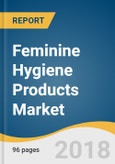The global feminine hygiene product market size is anticipated to reach USD 33.78 billion by 2025. It is anticipated to register a CAGR of 6.5% over the forecast period. The growth is catapulted by rise in disposable income, awareness among women regarding the available solutions, and commercialization of innovative and eco-friendly products. Initiatives by companies, government agencies, and self-help groups have resulted in raising awareness among women about various menstrual hygiene and sanitary products.
WaterAid, an international nonprofit organization, released a series of short films titled If Men Had Periods to raise awareness about lack of access to washrooms during menstruation for the global female population. Websites such as Menstrupedia and Wash United coupled with commercials, social media marketing campaigns, and awareness initiatives are expected to be lucrative for market growth in near future.
Asia Pacific held the largest market share in terms of revenue owing to the presence of a large female population and rise in disposable income. North America also constituted for a significant market share in terms of revenue due to availability of diverse products and high consumer awareness. Demand for innovative products such as menstrual cups and period panties is anticipated to further propel growth of the regional market.
Further key findings from the study suggest:
This product will be delivered within 1-3 business days.
WaterAid, an international nonprofit organization, released a series of short films titled If Men Had Periods to raise awareness about lack of access to washrooms during menstruation for the global female population. Websites such as Menstrupedia and Wash United coupled with commercials, social media marketing campaigns, and awareness initiatives are expected to be lucrative for market growth in near future.
Asia Pacific held the largest market share in terms of revenue owing to the presence of a large female population and rise in disposable income. North America also constituted for a significant market share in terms of revenue due to availability of diverse products and high consumer awareness. Demand for innovative products such as menstrual cups and period panties is anticipated to further propel growth of the regional market.
Further key findings from the study suggest:
- The menstrual care products segment, which consists of sanitary napkins, tampons, and menstrual cups, continue to hold the largest market share in terms of revenue. Repeated purchase and ease of usage are anticipated to drive the product demand
- Supermarkets is anticipated to remain the highest gaining distribution channel in the feminine hygiene product market over the forecast period. Availability of a diverse product range and easy accessibility are projected to propel the segment growth
- With the boom in e-commerce, online retail store segment is expected to gain a significant market share in near future
- Specialty and beauty stores offer a wide range of products under one roof. This segment is anticipated to hold a significant market share in terms of revenue. These stores offer discounts and other benefits, which is expected to bode well for the growth
- Asia Pacific held the largest market share owing to large female population and rising disposable income. North America, on the other hand, accounted for a considerable market share due to innovation and product diversity coupled with high awareness
- Some of the key market players are Glenmark, Lil-Lets UK Ltd., Procter & Gamble; Ontex; Natracare Bodywise, Unicharm Corporation, and Kimberly-Clark Corporation (KCWW) among others. Most companies engage in business collaborations to increase product penetration.
This product will be delivered within 1-3 business days.
Table of Contents
Chapter 1 Research Methodology
Chapter 2 Executive Summary
Chapter 3 Feminine Hygiene Market Variables, Trends & Scope
Chapter 4 Feminine Hygiene Market: Product Estimates & Trend Analysis
Chapter 5 Feminine Hygiene Market: Distribution Channel Estimates & Trend Analysis
Chapter 6 Feminine Hygiene Products Market: Regional Estimates & Trend Analysis, by Product, Distribution Channel
Chapter 7 Competitive Landscape
Companies Mentioned
- Procter and Gamble
- Edgewell Personal Care
- Unicharm Corporation
- Lil Lets
- Kimberly Clark
- SCA Essity
- Ontex International
- Natracare LLC
- Kao Corporation
- Summer’s Eve
Methodology

LOADING...








